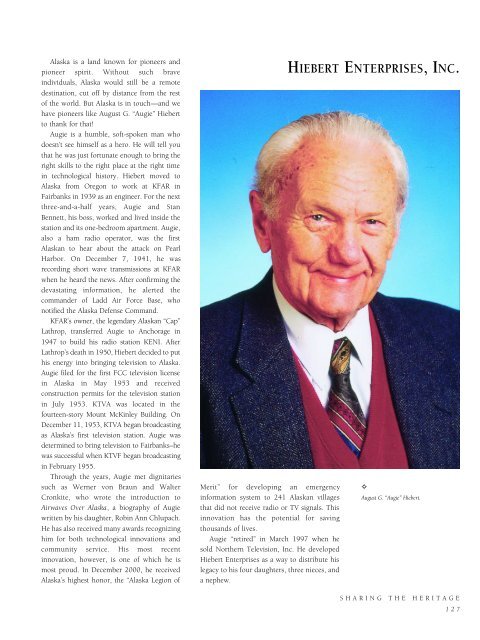Historic Anchorage
An illustrated history of the City of Anchorage, Alaska and the surrounding area, paired with the histories of companies, families and organizations that make the region great.
An illustrated history of the City of Anchorage, Alaska and the surrounding area, paired with the histories of companies, families and organizations that make the region great.
You also want an ePaper? Increase the reach of your titles
YUMPU automatically turns print PDFs into web optimized ePapers that Google loves.
Alaska is a land known for pioneers and<br />
pioneer spirit. Without such brave<br />
individuals, Alaska would still be a remote<br />
destination, cut off by distance from the rest<br />
of the world. But Alaska is in touch—and we<br />
have pioneers like August G. “Augie” Hiebert<br />
to thank for that!<br />
Augie is a humble, soft-spoken man who<br />
doesn’t see himself as a hero. He will tell you<br />
that he was just fortunate enough to bring the<br />
right skills to the right place at the right time<br />
in technological history. Hiebert moved to<br />
Alaska from Oregon to work at KFAR in<br />
Fairbanks in 1939 as an engineer. For the next<br />
three-and-a-half years, Augie and Stan<br />
Bennett, his boss, worked and lived inside the<br />
station and its one-bedroom apartment. Augie,<br />
also a ham radio operator, was the first<br />
Alaskan to hear about the attack on Pearl<br />
Harbor. On December 7, 1941, he was<br />
recording short wave transmissions at KFAR<br />
when he heard the news. After confirming the<br />
devastating information, he alerted the<br />
commander of Ladd Air Force Base, who<br />
notified the Alaska Defense Command.<br />
KFAR’s owner, the legendary Alaskan “Cap”<br />
Lathrop, transferred Augie to <strong>Anchorage</strong> in<br />
1947 to build his radio station KENI. After<br />
Lathrop’s death in 1950, Hiebert decided to put<br />
his energy into bringing television to Alaska.<br />
Augie filed for the first FCC television license<br />
in Alaska in May 1953 and received<br />
construction permits for the television station<br />
in July 1953. KTVA was located in the<br />
fourteen-story Mount McKinley Building. On<br />
December 11, 1953, KTVA began broadcasting<br />
as Alaska’s first television station. Augie was<br />
determined to bring television to Fairbanks–he<br />
was successful when KTVF began broadcasting<br />
in February 1955.<br />
Through the years, Augie met dignitaries<br />
such as Werner von Braun and Walter<br />
Cronkite, who wrote the introduction to<br />
Airwaves Over Alaska, a biography of Augie<br />
written by his daughter, Robin Ann Chlupach.<br />
He has also received many awards recognizing<br />
him for both technological innovations and<br />
community service. His most recent<br />
innovation, however, is one of which he is<br />
most proud. In December 2000, he received<br />
Alaska’s highest honor, the “Alaska Legion of<br />
Merit” for developing an emergency<br />
information system to 241 Alaskan villages<br />
that did not receive radio or TV signals. This<br />
innovation has the potential for saving<br />
thousands of lives.<br />
Augie “retired” in March 1997 when he<br />
sold Northern Television, Inc. He developed<br />
Hiebert Enterprises as a way to distribute his<br />
legacy to his four daughters, three nieces, and<br />
a nephew.<br />
HIEBERT ENTERPRISES, INC.<br />
✧<br />
August G. “Augie” Hiebert.<br />
SHARING THE HERITAGE<br />
127
















